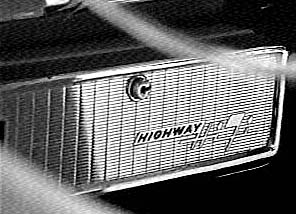 |
 |
 |
 |

|
on the Vocal Group Harmony Website
Spinning only the best in Rhythm & Blues
|
Your destinations: |
|
Home Listen To My Show Unca Marvy's Articles Places To Visit Things To Know My Ink Spots Book Surveys Fan Club Cards Other Neat Stuff |
|
|
|
»»» Contact Unca Marvy |
|||
|
MUSIC WHILE YOU DRIVE - ON THE HIGHWAY HI-FI Before there was the in-car CD player, before there was the in-car tape player, before there was the in-car 8-track player, even before there was the in-car 45 RPM record player, there was the Highway Hi-Fi. 
The unit was about four inches high and twelve inches wide. It mounted beneath the instrument panel and played through the regular radio speaker. The special 7-inch records (with the same small holes found in 78s and LPs) played between 45 minutes and an hour of music or speech. There was a storage area beneath the turntable that accomodated five records, held down by springs. (I can only wonder what a pleasant 90-degree Summer day, with the car parked in the sun, did for the disks.) The turntable pulled out partway for the passenger to change the record (I shudder to think of the driver doing this at speed). The pickup arm moved in the horizontal plane; it was only the stylus that moved vertically. (The stylus had springs to hold it against the record with two grams of pressure.) Remember, this isn't an automatic changer. One side of a record may last a long time, but sooner or later it has to be changed. Then, it becomes exceedingly manual. The 1956 Plymouth sales brochure claimed that you could safely change records while driving. "While you're driving, you can operate the Highway Hi-Fi with complete safety...no need to take your eyes from the road. Just pull out the drawer that's within easy reach of your right hand. Press the tab and swing the stylus arm and it automatically positions itself on the record. When the record has finished, press the tab when you wish and swing the arm to 'off'' position." I need some volunteers to try this. Can I see a show of hands? (I'm only taking those whose life insurance is both paid up and payable to me.) The same brochure also claimed that you could listen to "Classical music by the world's greatest artists. Hits from the Broadway stage. And recorded readings by stars of the legitimate theatre." This, at a time when music was undergoing its biggest revolution in decades. Maybe you could get away with that with Crysler and Imperial owners, but Plymouth and Dodge buyers probably wanted something a little different! Even worse, you couldn't play those records on anything else. The record sleeve warned: "This record is made for use only on the Highway Hi-Fi player in automobiles. It should not be played on other machines equipped with standard or microgroove needles." If you're curious what titles were offered (strangely, there are none on Red Robin or Chance), check out the listing here. The Highway Hi-Fi fiasco only lasted for two years (that is, through the 1958 model year). That's what happens with a proprietary product. You couldn't easily get new records, the unit wouldn't play the regular ones you already owned, and the special ones wouldn't play at home. There were also mechanical problems, and warranty costs were pretty high. It didn't take long for dealers to stop pushing the unit. Another problem was that it had an AC induction motor with an electromechanical vibrator (which converted the car's DC into AC). This produced noise; lots of noise. It was also failure-prone. The Highway Hi-Fi was quietly (or, possibly, noisily) dropped.  In 1959, Chrysler offered no in-car record player. They were gearing up for the 1960 model year, at which time they switched over to the RCA Victor Auto Victrola. Since, it was felt, drivers were determined to take their tunes with them, the Auto Victrola allowed you to stack fourteen 45 RPM discs, for up to two hours of play. At least now you could leave your own records out in the sun to warp. Not a terribly reliable piece of equipment, this bright idea also only lasted for two model years. We can take the narrow view: the Highway Hi-Fi made no provision to play Drifters records, so what good was it? However, almost no one seemed to be pleased with either the selection or the operation. Goldmark would have done better to have developed the CD. |

